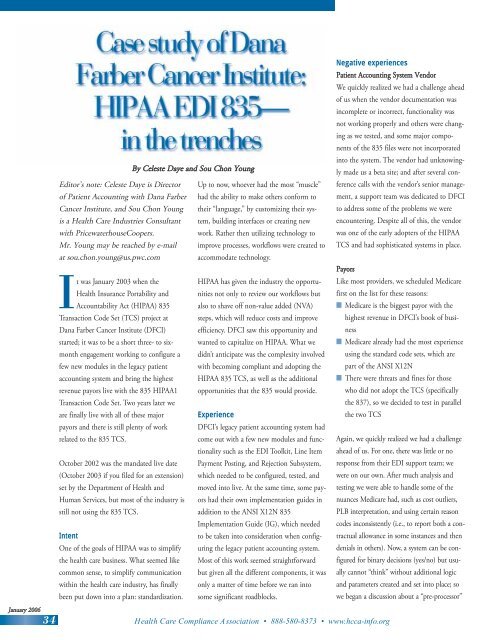MD - Health Care Compliance Association
MD - Health Care Compliance Association
MD - Health Care Compliance Association
Create successful ePaper yourself
Turn your PDF publications into a flip-book with our unique Google optimized e-Paper software.
By Celeste Daye and Sou Chon Young<br />
Editor’s note: Celeste Daye is Director Up to now, whoever had the most “muscle”<br />
of Patient Accounting with Dana Farber had the ability to make others conform to<br />
Cancer Institute, and Sou Chon Young their “language,” by customizing their system,<br />
building interfaces or creating new<br />
is a <strong>Health</strong> <strong>Care</strong> Industries Consultant<br />
with PricewaterhouseCoopers.<br />
work. Rather then utilizing technology to<br />
Mr. Young may be reached by e-mail improve processes, workflows were created to<br />
at sou.chon.young@us.pwc.com<br />
accommodate technology.<br />
It was January 2003 when the<br />
HIPAA has given the industry the opportunities<br />
not only to review our workflows but<br />
<strong>Health</strong> Insurance Portability and<br />
Accountability Act (HIPAA) 835 also to shave off non-value added (NVA)<br />
Transaction Code Set (TCS) project at steps, which will reduce costs and improve<br />
Dana Farber Cancer Institute (DFCI) efficiency. DFCI saw this opportunity and<br />
started; it was to be a short three- to sixmonth<br />
engagement working to configure a didn’t anticipate was the complexity involved<br />
wanted to capitalize on HIPAA. What we<br />
few new modules in the legacy patient with becoming compliant and adopting the<br />
accounting system and bring the highest HIPAA 835 TCS, as well as the additional<br />
revenue payors live with the 835 HIPAA1 opportunities that the 835 would provide.<br />
Transaction Code Set. Two years later we<br />
are finally live with all of these major Experience<br />
payors and there is still plenty of work DFCI’s legacy patient accounting system had<br />
related to the 835 TCS.<br />
come out with a few new modules and functionality<br />
such as the EDI Toolkit, Line Item<br />
October 2002 was the mandated live date Payment Posting, and Rejection Subsystem,<br />
(October 2003 if you filed for an extension) which needed to be configured, tested, and<br />
set by the Department of <strong>Health</strong> and moved into live. At the same time, some payors<br />
had their own implementation guides in<br />
Human Services, but most of the industry is<br />
still not using the 835 TCS.<br />
addition to the ANSI X12N 835<br />
Implementation Guide (IG), which needed<br />
Intent<br />
to be taken into consideration when configuring<br />
the legacy patient accounting system.<br />
One of the goals of HIPAA was to simplify<br />
the health care business. What seemed like Most of this work seemed straightforward<br />
common sense, to simplify communication but given all the different components, it was<br />
within the health care industry, has finally only a matter of time before we ran into<br />
been put down into a plan: standardization. some significant roadblocks.<br />
Negative experiences<br />
Patient Accounting System Vendor<br />
We quickly realized we had a challenge ahead<br />
of us when the vendor documentation was<br />
incomplete or incorrect, functionality was<br />
not working properly and others were changing<br />
as we tested, and some major components<br />
of the 835 files were not incorporated<br />
into the system. The vendor had unknowingly<br />
made us a beta site; and after several conference<br />
calls with the vendor’s senior management,<br />
a support team was dedicated to DFCI<br />
to address some of the problems we were<br />
encountering. Despite all of this, the vendor<br />
was one of the early adopters of the HIPAA<br />
TCS and had sophisticated systems in place.<br />
Payors<br />
Like most providers, we scheduled Medicare<br />
first on the list for these reasons:<br />
■ Medicare is the biggest payor with the<br />
highest revenue in DFCI’s book of business<br />
■ Medicare already had the most experience<br />
using the standard code sets, which are<br />
part of the ANSI X12N<br />
■ There were threats and fines for those<br />
who did not adopt the TCS (specifically<br />
the 837), so we decided to test in parallel<br />
the two TCS<br />
Again, we quickly realized we had a challenge<br />
ahead of us. For one, there was little or no<br />
response from their EDI support team; we<br />
were on our own. After much analysis and<br />
testing we were able to handle some of the<br />
nuances Medicare had, such as cost outliers,<br />
PLB interpretation, and using certain reason<br />
codes inconsistently (i.e., to report both a contractual<br />
allowance in some instances and then<br />
denials in others). Now, a system can be configured<br />
for binary decisions (yes/no) but usually<br />
cannot “think” without additional logic<br />
and parameters created and set into place; so<br />
we began a discussion about a “pre-processor”<br />
January 2006<br />
34<br />
<strong>Health</strong> <strong>Care</strong> <strong>Compliance</strong> <strong>Association</strong> • 888-580-8373 • www.hcca-info.org

















